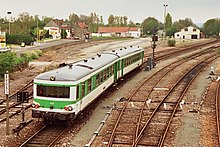Quercyrail
Quercyrail is a French association based in Cajarc , which ran a tourist museum operation with old railway vehicles from 1993 to 2003 . The name is made up of the terms Quercy , the historical name for the area around Cahors , and rail (rail, in the broader sense "railway") together. In addition to numerous voluntary employees, the association also had several permanent employees.
history
The association was founded in 1984 under the name "Regiorail". The aim was to maintain the scenic Cahors – Capdenac railway line along the Lot River , which since 1980 has only been used by freight trains. On June 17, 1985, a round trip was offered for the first time with a multiple unit rented from the state railway SNCF . A diesel multiple unit of the X 2800 series with an XR-6000 sidecar was used , the tour led from Cahors via Capdenac , Rocamadour and Brive-la-Gaillarde back to Cahors.
The income from the first events enabled the association to acquire its own locomotive in November 1985 . The choice fell on the X Series 2425 X 2400 and to the Decauville -Beiwagen XR 8,232th soon followed the 1986 parked RGP2 - Multiple Unit X 2709. With the acquisition was on the renting of SNCF vehicles for the "Tours du Lot" be waived.

On July 14, 1986 was on track Cahors Capdenac steam train with the locomotive 141 TD 740 of the Train à vapeur en Limousin used. Corresponding trips were carried out annually until 2003 on the French national holiday . In 1989, the SNCF also stopped freight traffic on the route. However, in 1990 the association was able to stop the dismantling of the facilities, which had already begun.
At the beginning of 1990, the locks in the Lot , which had been out of service since 1926, were repaired in order to be able to offer tourist traffic with Pénichettes on the river . After long negotiations, the Ministry of Transport approved the association in 1992 to operate museum trains on the parallel railway line. In 1993 he concluded a corresponding agreement with the SNCF and the departmental councils of the Lot and Aveyron departments . The line was handed over to the two departments, which in turn entrusted Quercyrail with its maintenance and operation. The train stations in Cahors and Capdenac could be approached by the museum trains, the maintenance of the barriers and light signals at the level crossings remained with the SNCF. This created the longest museum railway in the country. After repair work carried out by volunteers, tourist traffic was resumed between Cahors and Cajarc in May 1993. In addition to pure train journeys, combined train / boat journeys as well as hikes, sightseeing and gastronomic stays connected with train journeys were offered.

Between May and October 1993, 47 trains ran on the route; three years later there were already 120 trains carrying 10,000 passengers. In 2003 around 15,000 passengers were counted. In 1997, another diesel multiple unit, the "Caravelle" X 4511, was purchased, which proved to be well suited for tourist traffic because of the large windows. The X 4519 and the "Picasso" X 3825 followed soon after, and a small locomotive , two draisines and several freight cars were also purchased.
In 1997, the "Truffadou" was a second tourist museum railway in the Quercy. In that year, the Cahors – Capdenac line was transferred to the infrastructure company Réseau ferré de France (RFF), while technical control remained with the SNCF. In spring 2002, during the construction of the A 20 motorway bridge over the Lot, the route was used for freight transport to transport parts of the bridge. Those responsible, their operating company Autoroutes du Sud de la France (ASF), repeatedly chartered vehicles from Quercyrail in order to visit the construction site, which was difficult to reach by road.
On December 28, 2003 a train from Quercyrail ran between Cahors and Capdenac for the last time. In order to be granted the operating license for 2004, the SNCF requested the prior exchange of 1,000 sleepers , but the estimated costs of around 100,000 euros exceeded the association's financial resources. Since then, the route has not been used by trains. On June 9, 2011, it was shut down by RFF and has now been partially dismantled. The association tries to maintain the 16 km long section Cajarc - Saint-Cirq-Lapopie , the vegetation is regularly removed by volunteers. In 2018, Quercyrail tried to resume rail operations with new, light vehicles and was looking for partners to finance it. In 2019 negotiations took place with the city administration of Cajarc regarding the use of the locomotive shed there . The association's “Picasso” railcar is to be refurbished.
Web links
- Historique du train touristique "Quercyrail" at quercyrail.fr
- Ride with the railcar X 2425 from Quercyrail on the Cahors – Capdenac route (1997) on YouTube
Individual evidence
- ↑ Locomotive à vapeur 141 TD 740 - Détails at trainvapeur.com, accessed on June 1, 2020
- ↑ Notre histoire at trainduhautquercy.info, accessed on June 1, 2020
- ↑ Débroussaillage de la ligne at quercyrail.fr, accessed on June 1, 2020
- ↑ https://www.ladepeche.fr/article/2018/05/07/2793229-une-navette-legere-autonome-le-nouveau-projet-de-quercyrail.html Cajarc. Une navette légère autonome, le nouveau projet de Quercyrail at ladepeche.fr, accessed on June 1, 2020
- ^ Cajarc. Être présente sur tous les fronts at ladepeche.fr, accessed on June 1, 2020
